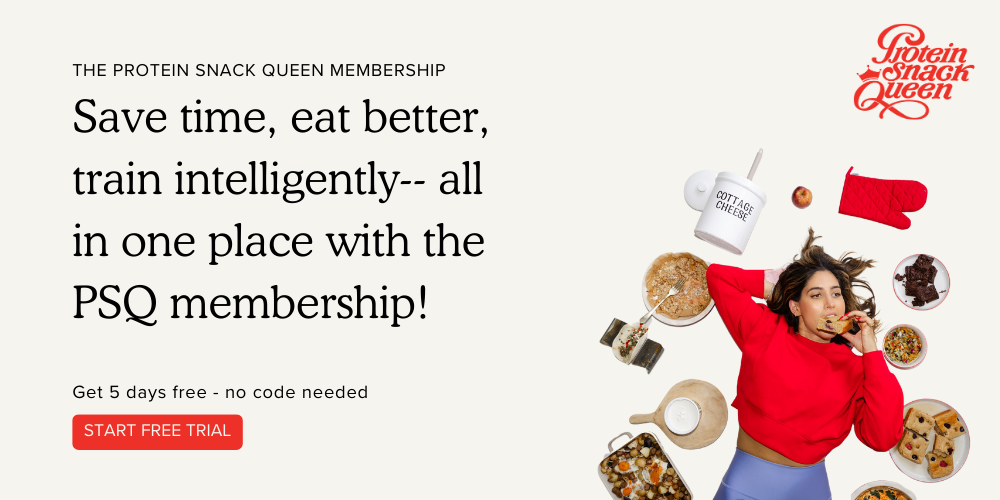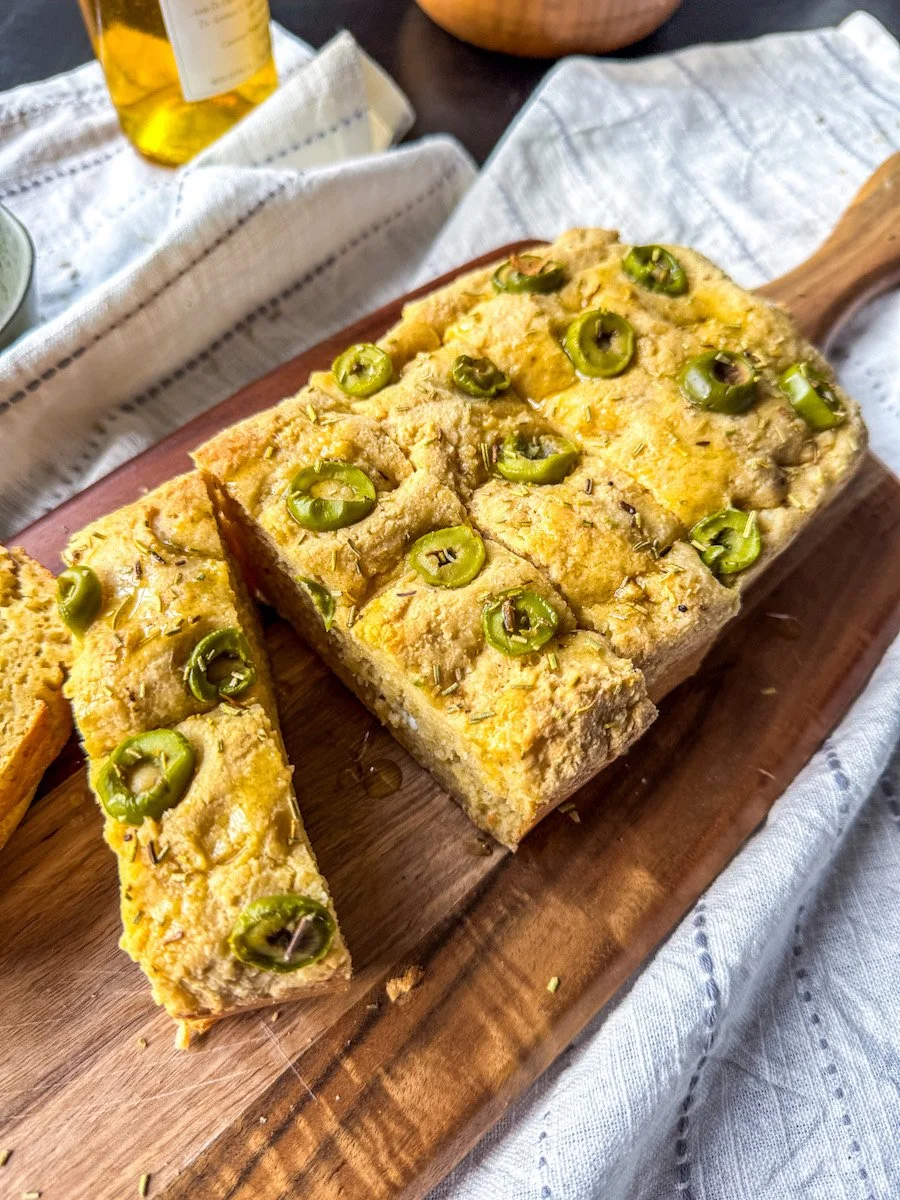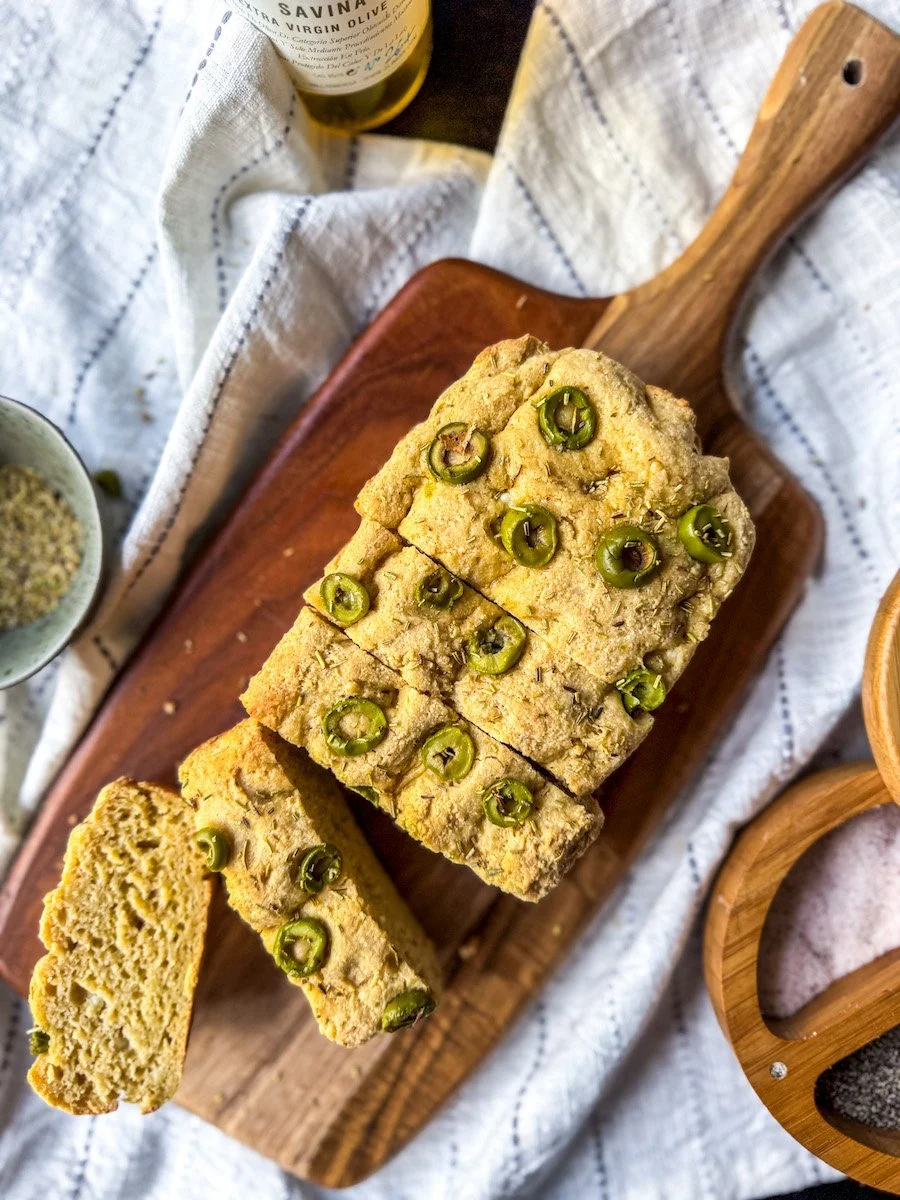The Best High-Protein Gluten-Free Focaccia Recipe
Makes: 6 Servings
Per Serving: 13g Protein | 133 Cal
Most breads and baked goods aren’t exactly high-protein— but we love them anyway! So, what if we could actually make a bread that is both DELICIOUS and high in protein? And when you’re craving a sandwich, happy hour snack, or side dish for soup, stew, or anything else, it can be useful to have a recipe to turn to that’ll deliver the bready, comforting dish you’re looking for, while helping you hit your protein goals!
That’s where this high-protein, gluten-free focaccia comes in. Yeast-free (meaning no kneading, proofing, or resting required) and full of savory, fresh Mediterranean flavors thanks to the addition of fragrant rosemary, punchy garlic, and briny olives, this delicious bread is just as good as a side for soup as it is when sliced for a sandwich.
And yes, I am aware that focaccia is traditionally baked in some type of sheet pan, but I chose to use a bread pan! That doesn’t mean you have to!
What’s the Difference Between This Focaccia & Traditional Focaccia?
This version is very different from the traditional forms you’ll find in bakeries and many kitchens.
Traditional focaccia recipes use yeast for rise, all-purpose or bread flour, olive oil, and salt, and require kneading the dough to develop the gluten, time to rest and proof so that the dough will develop its signature flavor and texture, and more. Because of all of this, traditional focaccia generally has a chewy crumb and airy interior with a golden crust and olive oil for added richness and flavor. It’s undoubtedly delicious, but it’s not high in protein.
This higher-protein, gluten-free focaccia, on the other hand, doesn’t include yeast or all-purpose or bread flour. Instead, you’ll work with cottage cheese, casein protein powder, oat flour, coconut flour, and baking power to give it a little lift. The leavener is super important in this recipe because you won’t have the yeast and all of the kneading to help the dough rise like a traditional focaccia would. But this version gives you a whopping 13g of protein per slice of bread (more than traditional versions).
The texture of gluten-free bread is nearly always going to be different from breads made with gluten. This focaccia is a bit denser and softer than other focaccias, but it still has some of the traditional flavors and accouterments that traditional focaccias tend to incorporate like rosemary, olive oil, olives, garlic, and flaky salt.
Yeasted breads also notoriously take some time to make because you have to give the dough time for the yeast to work, the dough to proof and ferment, and the like. Because this high-protein version doesn’t use yeast (aka, it’s a quick-bread), you can mix up this simple dough in under 30 minutes. You don’t have to knead the dough or wait for it to do its thing. It’s a savory, delicious, protein-rich bread that you can eat shortly after you start to make it.
Basically, if you’re looking for an authentic, Italian experience, you’re better off going for the traditional version. But if your priority is balancing the focaccia flavors you love with the macros that will fit into your health and fitness goals, you should definitely give my high-protein, gluten-free focaccia a try.
Why You’ll Love This Gluten-Free Focaccia Bread Recipe
Packed with protein: Because of the cottage cheese and protein powder, this focaccia is actually sneakily high in protein. Each slice contains 13g!
Gluten-free: This bread is made with oat flour and coconut flour instead of regular all-purpose flour, which means you can very easily make it gluten-free (just make sure your oat flour is gluten-free certified!).
Great for meal prep: Whether you’re looking for something you can serve to a group or an easy snack or ingredient for your week ahead, this bread is a great option. It makes 6 slices, so you can make a batch and eat for days.
Savory and delicious: With the addition of rosemary, garlic, and olives, you get maximum flavor in every bite.
Versatile and easy to customize: Not a rosemary fan? Hate olives? No problem! Try mixing things up with other herbs and veggies. Use shaved summer squash, sun-dried or roasted tomatoes, caramelized onions, and more to really make it your own.
Ingredients
1 cup (240g) low-fat cottage cheese, blended smooth
2 large eggs
2 scoops (30g) unflavored casein protein powder
1/2 cup (60g) oat flour
2 tablespoons (14g) coconut flour
2 tablespoons Castelvetrano olives, chopped (sub: any green or black olives)
1 tablespoon dried rosemary
1.5 teaspoons baking powder
1/2 teaspoon garlic powder
1/2 teaspoon salt
1 tablespoon extra virgin olive oil, plus more for drizzling
Toppings: fresh rosemary, flaky sea salt, more olives
Instructions
Preheat the oven and prep the pan: Turn on your oven and preheat it to 350 degrees F. Line an 8x8 baking dish (or quarter sheet pan) with parchment paper and drizzle it with a little olive oil.
Mix the wet ingredients: Blend the cottage cheese until smooth and add it to a large mixing bowl, then stir in the eggs, olive oil, and chopped olives. Mix well to combine.
Mix the dry ingredients: In a large bowl, whisk together the casein protein powder, oat flour, coconut flour, baking powder, garlic powder, salt, and dried rosemary.
Make the dough: Add the wet ingredients to the large bowl with the dried ingredients and mix with a wooden spoon until a thick batter forms. Let the dough rest for about 3-5 minutes for best results. It'll give you time so that the coconut flour and casein protein can absorb some of the moisture.
Add to the pan: Transfer the dough to the prepared pan and use lightly wet hands to press it evenly into the pan.
Dimple the dough: Wet your fingertips and dimple the entire top of the dough to give it that signature focaccia look. Add any toppings you’d like (rosemary, extra olives, roasted garlic), drizzle the whole thing with olive oil, and top with some flaky salt.
Bake: Transfer the pan to the preheated oven and bake for about 22-26 minutes, or until the bread is golden brown and a tester inserted into the center comes out clean.
Cool: Let the bread cool, then slice and enjoy!
Nutrition Info (Per Slice - Makes 6 Slices)
Calories: 133
Protein: 13g
Carbs: 12g
Fat: 4g
Swaps & Substitutions
Add cheese: Sprinkle a little grated or shredded parmesan cheese, crumbled feta, a bit of Boursin, or even tiny mozzarella pearls on top before baking for a cheesy twist.
Try a different herb: Instead of rosemary, use thyme, oregano, fresh herbs, or even an Italian seasoning blend. Any of these would be a perfect choice.
Give it some heat: Add a sprinkle chili flakes or a drizzle or Calabrian chili sauce on top.
Use different toppings: Go for sun-dried tomatoes, roasted tomatoes, caramelized onions, roasted garlic cloves, shaved summer squash, chopped artichoke hearts, roasted eggplant, marinated mushrooms, or whatever else you love! You can use just about anything!
FAQs
-
I really prefer baking with casein protein powder instead of something like whey because it just yields better results. It gives you that baked goods texture you’re looking for. It’s worth keeping on hand, even if just for high-protein baking!
-
One of the best things about this bread is how versatile it is! Serve with roasted chicken, soups, stews, baked fish, grilled or marinated veggies, a savory salad, as a sandwich, or even just with a cocktail and some snacks for an upscale happy hour.
-
Store any leftover focaccia in an airtight container in the fridge for up to 4 days. When you’re ready to eat, you can gently warm it in the oven, toaster oven, or air fryer—it’ll give you the best texture!
-
You sure can! If you want to store it in the freezer, I’d recommend slicing the bread first, then wrapping it individually in parchment paper and a tight layer of plastic wrap, before placing it in an airtight container or freezer bag and freezing for up to 2 months. When you’re ready to eat, pull a slice out of the freezer and warm it up in the oven or air fryer—there’s no need to thaw it first.
-
I haven’t tested it, so I’m not sure how it will turn out, but if you want to try to make this recipe dairy-free, I would recommend substituting silken tofu or plant-based yogurt for the cottage cheese and using a pea protein isolate instead of the casein protein powder.
-
I’m not sure exactly how subbing out the coconut flour would work out, so I wouldn’t recommend it, but if you’re determined to make this recipe without the coconut flour, I’d try upping the oat flour by about 2-3 tablespoons. One thing to keep in mind if you choose to try doing this: coconut flour absorbs much more liquid than oat flour does, so the texture will be different if you’re using only oat flour. You could also experiment by making this recipe with a gluten-free flour mix (like Bob's Red Mill) instead of both the oat flour and coconut flour, but I haven't tried that myself, so I'm not sure how it would turn out!
-
You don’t want a focaccia bread that’s too dense or too dry. That can often happen if you use too much protein powder or not enough liquid. Make sure that you blend the cottage cheese completely smooth and then let the focaccia dough rest for a bit before you bake your bread so that you can make sure the flours hydrate correctly.
-
I haven’t personally tested the recipe with the ingredients needed to make it vegan, but if you’re trying to adapt this recipe for whatever reason, you’ll need to make some changes in order to make it so. Instead of the cottage cheese, try using a plant-based, dairy-free yogurt or silken tofu. For the casein protein, swap in a pea protein powder. And finally, for the eggs, use chia eggs or flax eggs. All of these swaps and substitutions will change the texture a bit, so just be aware of that before taking the plunge.
-
I like using an 8x8-inch square pan for thick, bread-like slices, but you can also use a loaf pan for taller slices or get thinner slices with a crispy crust by spreading the bread dough out onto a parchment paper-lined quarter sheet pan. No matter the shape of the pan you’re using, you really can’t go wrong, but if you’re looking for the most authentically traditional choice, go for the baking sheet!
-
One of the best things about this recipe is how versatile it is when it comes to toppings. Try sun-dried tomatoes, roasted tomatoes, caramelized onions, roasted bell peppers, marinated mushrooms, chopped artichoke hearts, other types of olives, roasted eggplant, shaved summer squash, diced and roasted butternut squash, and more. You could also mix it up with a sprinkle of parmesan, feta, Boursin, or goat cheese, and try different herbs like oregano, sage, thyme, parsley, dill, and more. The options are basically endless.
-
Yes, this recipe is naturally gluten-free, because it uses a combination of oat flour and coconut flour instead of wheat flour. That being said, you’ll need to double check and make sure that your oat flour (and, to be safe, any other ingredients) are certified gluten-free. Sometimes oats can be contaminated with gluten. So though oats don’t naturally contain gluten, packaged oat products can.
-
The only real changes you’ll need to make to the recipe if you want to make more than just a single batch of this gluten-free focaccia are the size of the pan you bake it in and the amount of time you let it bake up in the oven. If you want to double the recipe, you can double the ingredients and then either bake it in 2 prepared pans, or bake it in a 9x13-inch baking dish instead of the 8x8 square. Prefer to use a baking pan? Either use 2 quarter sheet pans or 1 half sheet pan. Add a few extra minutes to the bake time, and bake until the bread is golden brown, the bottom crust is crispy, and a tester inserted into the center of the bread dough comes out clean.
This gluten-free focaccia recipe is a total game-changer. Packed with protein, yeast-free, easy to make, and endlessly versatile and customizable, it’s the perfect recipe to keep in your repertoire for whenever you’re craving a bit of bread and still want to hit your macro goals. Great as an easy side dish, pre- or post-workout snack, quick breakfast (it’d make a great breakfast sandwich!), or as the base for a high-protein sandwich for lunch or dinner, this bread is one you’ll want to keep on hand all the time.
You may as well make a double batch!

Gluten-Free Focaccia
This gluten free focaccia is high in protein, easy to make, and super customizable—you’re going to love it!
Ingredients
- 1 cup (240g) low-fat cottage cheese, blended smooth
- 2 large eggs
- 2 scoops (30g) unflavored casein protein powder
- 1/2 cup (60g) oat flour
- 2 tablespoons (14g) coconut flour
- 2 tablespoons Castelvetrano olives, chopped (sub: any green or black olives)
- 1 tablespoon dried rosemary
- 1.5 teaspoons baking powder
- 1/2 teaspoon garlic powder
- 1/2 teaspoon salt
- 1 tablespoon extra virgin olive oil, plus more for drizzling
- Toppings: fresh rosemary, flaky sea salt, more olives
Instructions
- Preheat the oven and prep the pan: Turn on your oven and preheat it to 350 degrees F. Line an 8x8 baking dish (or quarter sheet pan) with parchment paper and drizzle it with a little olive oil.
- Mix the wet ingredients: Blend the cottage cheese until smooth and add it to a large mixing bowl, then stir in the eggs, olive oil, and chopped olives. Mix well to combine.
- Mix the dry ingredients: In a large bowl, whisk together the casein protein powder, oat flour, coconut flour, baking powder, garlic powder, salt, and dried rosemary.
- Make the dough: Add the wet ingredients to the large bowl with the dried ingredients and mix with a wooden spoon until a thick batter forms. Let the dough rest for about 3-5 minutes for best results. It'll give you time so that the coconut flour and casein protein can absorb some of the moisture.
- Add to the pan: Transfer the dough to the prepared pan and use lightly wet hands to press it evenly into the pan.
- Dimple the dough: Wet your fingertips and dimple the entire top of the dough to give it that signature focaccia look. Add any toppings you’d like (rosemary, extra olives, roasted garlic), drizzle the whole thing with olive oil, and top with some flaky salt.
- Bake: Transfer the pan to the preheated oven and bake for about 22-26 minutes, or until the bread is golden brown and a tester inserted into the center comes out clean.
- Cool: Let the bread cool, then slice and enjoy!
Nutrition Facts
Calories
133Fat
3 gCarbs
12 gProtein
13 gNutrition facts are calculated by adding every ingredient and dividing it by the number of servings.





